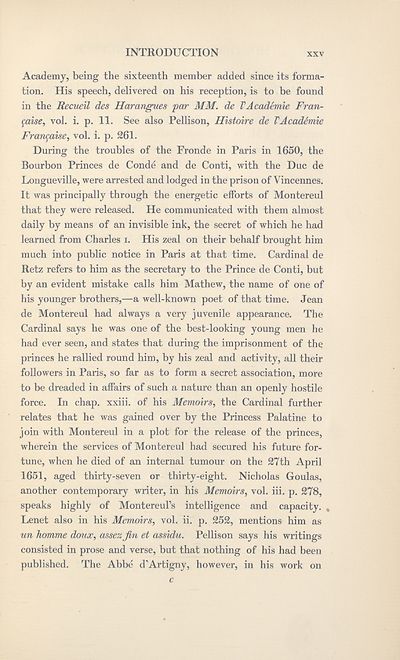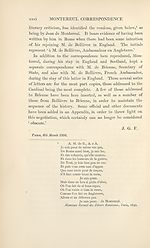Series 1 > Diplomatic correspondence of Jean de Montereul and the brothers de Bellièvre, French ambassadors in England and Scotland, 1645-48 > Volume 1
(30) Page xxv
Download files
Complete book:
Individual page:
Thumbnail gallery: Grid view | List view

INTRODUCTION
XXV
Academy, being the sixteenth member added since its forma¬
tion. His speech, delivered on his reception, is to be found
in the Recueil des Harangues par MM. de VAcademic Fran-
$aise, vol. i. p. 11. See also Pellison, Histoire de VAcadSmie
Frarupise, vol. i. p. 261.
During the troubles of the Fronde in Paris in 1650, the
Bourbon Princes de Conde and de Conti, with the Due de
Longueville, were arrested and lodged in the prison of Vincennes.
It was principally through the energetic efforts of Montereul
that they were released. He communicated with them almost
daily by means of an invisible ink, the secret of which he had
learned from Charles i. His zeal on their behalf brought him
much into public notice in Paris at that time. Cardinal de
Retz refers to him as the secretary to the Prince de Conti, but
by an evident mistake calls him Mathew, the name of one of
his younger brothers,—a well-known poet of that time. Jean
de Montereul had always a very juvenile appearance. The
Cardinal says he was one of the best-looking young men he
had ever seen, and states that during the imprisonment of the
princes he rallied round him, by his zeal and activity, all their
followers in Paris, so far as to form a secret association, more
to be dreaded in affairs of such a nature than an openly hostile
force. In chap, xxiii. of his Memoirs, the Cardinal further
relates that he was gained over by the Princess Palatine to
join with Montereul in a plot for the release of the princes,
wherein the services of Montereul had secured his future for¬
tune, when he died of an internal tumour on the 27th April
1651, aged thirty-seven or thirty-eight. Nicholas Goulas,
another contemporary writer, in his Memoirs, vol. iii. p. 278,
speaks highly of Montereul’s intelligence and capacity. ,
Lenet also in his Memoirs, vol. ii. p. 252, mentions him as
un homme doux, assez Jin et assidu. Pellison says his writings
consisted in prose and verse, but that nothing of his had been
published. The Abbe d’Artigny, however, in his work on
XXV
Academy, being the sixteenth member added since its forma¬
tion. His speech, delivered on his reception, is to be found
in the Recueil des Harangues par MM. de VAcademic Fran-
$aise, vol. i. p. 11. See also Pellison, Histoire de VAcadSmie
Frarupise, vol. i. p. 261.
During the troubles of the Fronde in Paris in 1650, the
Bourbon Princes de Conde and de Conti, with the Due de
Longueville, were arrested and lodged in the prison of Vincennes.
It was principally through the energetic efforts of Montereul
that they were released. He communicated with them almost
daily by means of an invisible ink, the secret of which he had
learned from Charles i. His zeal on their behalf brought him
much into public notice in Paris at that time. Cardinal de
Retz refers to him as the secretary to the Prince de Conti, but
by an evident mistake calls him Mathew, the name of one of
his younger brothers,—a well-known poet of that time. Jean
de Montereul had always a very juvenile appearance. The
Cardinal says he was one of the best-looking young men he
had ever seen, and states that during the imprisonment of the
princes he rallied round him, by his zeal and activity, all their
followers in Paris, so far as to form a secret association, more
to be dreaded in affairs of such a nature than an openly hostile
force. In chap, xxiii. of his Memoirs, the Cardinal further
relates that he was gained over by the Princess Palatine to
join with Montereul in a plot for the release of the princes,
wherein the services of Montereul had secured his future for¬
tune, when he died of an internal tumour on the 27th April
1651, aged thirty-seven or thirty-eight. Nicholas Goulas,
another contemporary writer, in his Memoirs, vol. iii. p. 278,
speaks highly of Montereul’s intelligence and capacity. ,
Lenet also in his Memoirs, vol. ii. p. 252, mentions him as
un homme doux, assez Jin et assidu. Pellison says his writings
consisted in prose and verse, but that nothing of his had been
published. The Abbe d’Artigny, however, in his work on
Set display mode to:
![]() Universal Viewer |
Universal Viewer | ![]() Mirador |
Large image | Transcription
Mirador |
Large image | Transcription
Images and transcriptions on this page, including medium image downloads, may be used under the Creative Commons Attribution 4.0 International Licence unless otherwise stated. ![]()
| Permanent URL | https://digital.nls.uk/127021809 |
|---|
| Shelfmark | SCS.SHS.29 |
|---|---|
| Attribution and copyright: |
|
| Attribution and copyright: |
|
|---|
| Description | Over 180 volumes, published by the Scottish History Society, containing original sources on Scotland's history and people. With a wide range of subjects, the books collectively cover all periods from the 12th to 20th centuries, and reflect changing trends in Scottish history. Sources are accompanied by scholarly interpretation, references and bibliographies. Volumes are usually published annually, and more digitised volumes will be added as they become available. |
|---|


